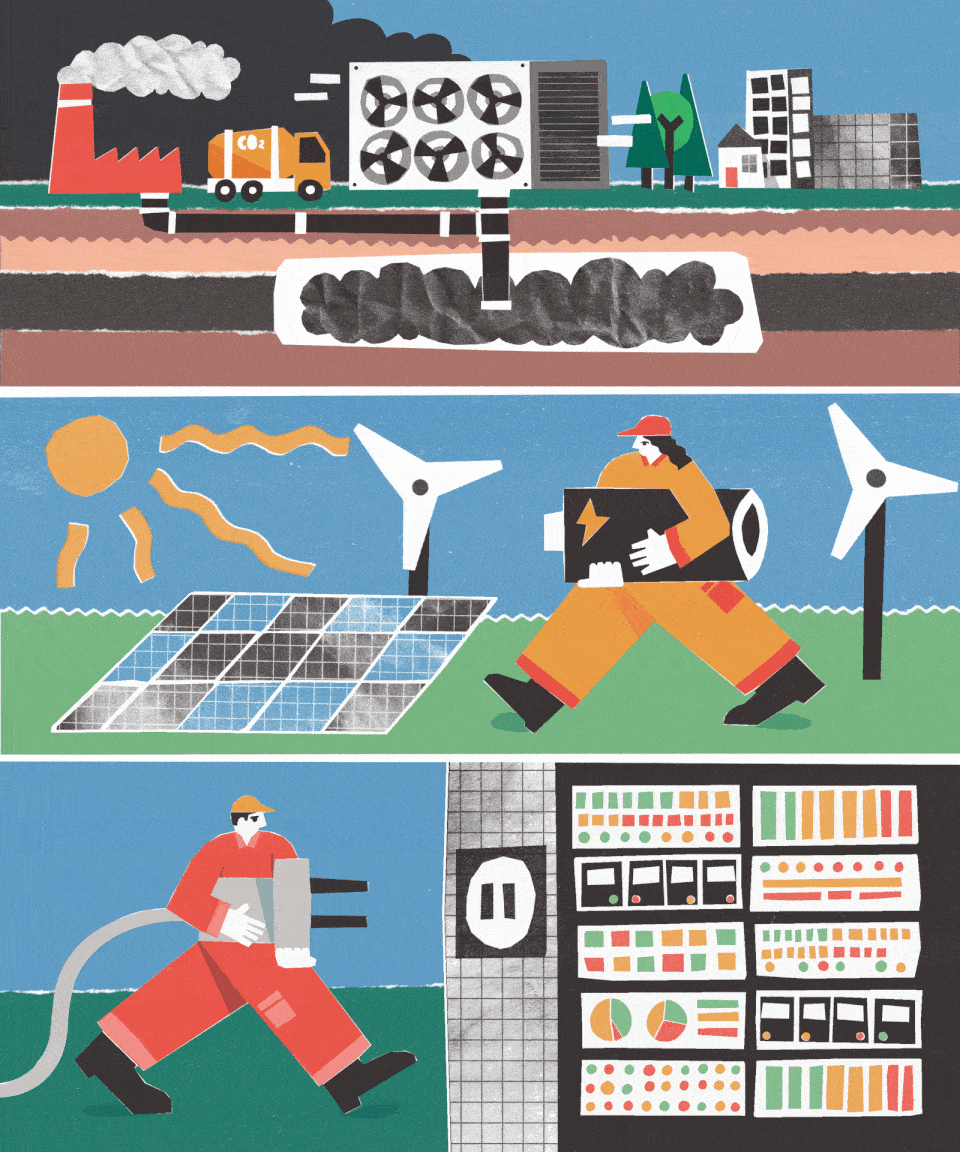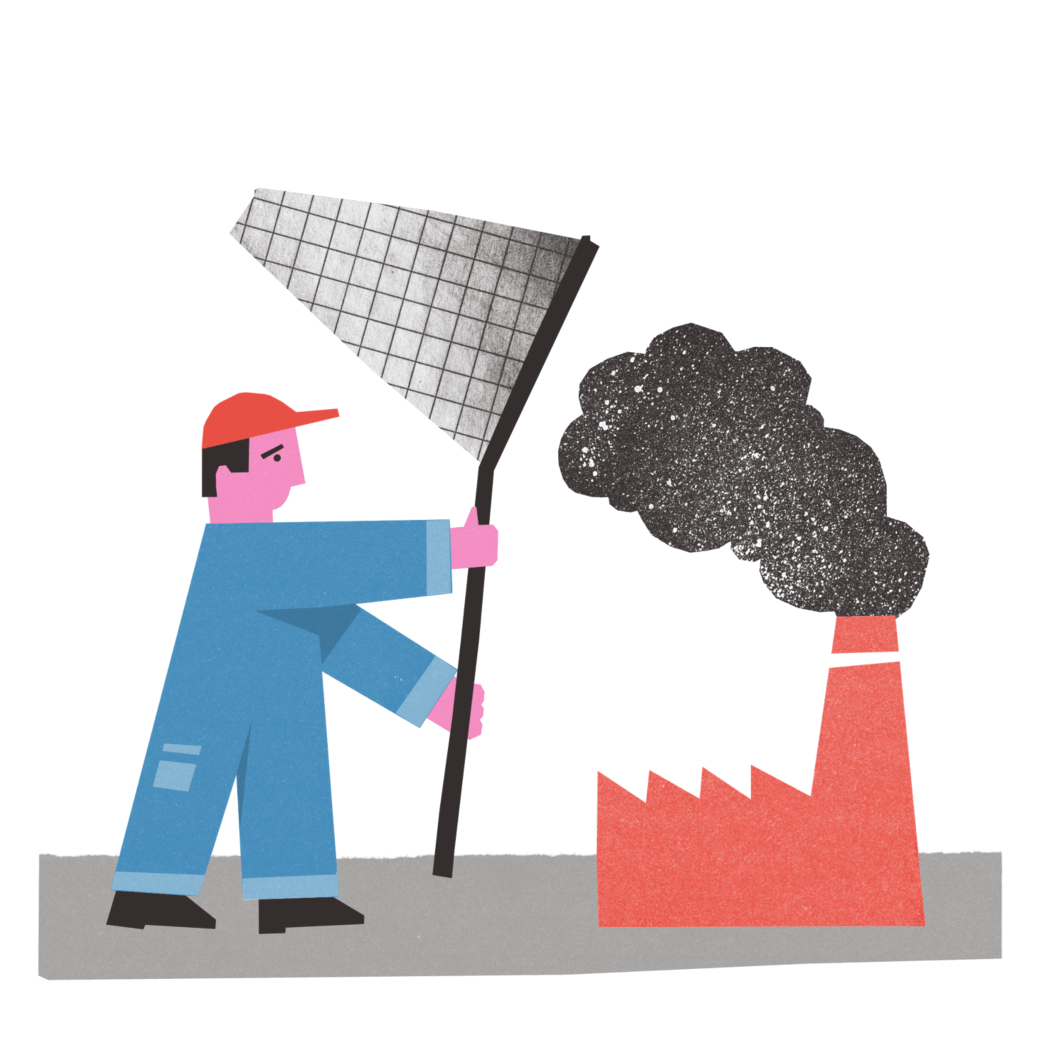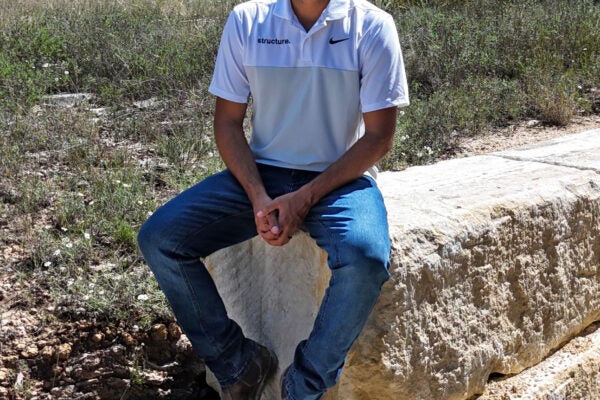
Energy Innovators, Made in Texas
McCOMBS Alumni Lead on Energy’s Latest Developments: Generating It, Storing It, Cleaning It Up
by Steve Brooks
illustrations by Dionne Kitching

In the Nevada desert, a startup is repurposing oil field technologies to create a new kind of geothermal plant — one that turns electric turbines without using geysers and other existing geological reservoirs. On the south side of Houston, a massive array of batteries can power at least 60,000 homes, storing electricity when it’s abundant and releasing it when it’s not. In Corpus Christi and Sabine Pass, a liquefied natural gas company is finding new export markets, helping to wean Europe off Russian oil and to wean the world off coal-fired power.
Across 20 countries, a company is building sustainable data centers to host the next wave of massive energy-consuming artificial intelligence and cloud computing. The centers minimize landfill trash and wastewater while using 100% carbon-free energy.
What do these varied energy ventures have in common? They all involve alumni of Texas McCombs and are among the most innovative developments in the energy industry.
Aside from earning degrees from McCombs, alumni innovators at these companies benefited from taking part in an interdisciplinary collaboration of four schools at The University of Texas at Austin: business, law, engineering, and geosciences. The goal is to create graduates with holistic energy perspectives that integrate the four disciplines.
“We want the engineers doing things that are novel, but at the end of the day, we’ve got to filter it back through a policy lens and an economics lens,” says John C. Butler, clinical associate professor of finance at McCombs and academic director of the Kay Bailey Hutchison Energy Center. “A key definition of sustainability is that it can pay for itself.”
Energy innovation is nothing new for Texas or its flagship university, notes the KBH Energy Center’s namesake, former U.S. Sen. Kay Bailey Hutchison. “Texas is the center of United States energy,” she says. “It’s the center of production, it’s been the center of research, and now, it’s the center of the use of renewables.”

Energy innovation is nothing new for Texas or its flagship university, notes the KBH Energy Center’s namesake, former U.S. Sen. Kay Bailey Hutchison. “Texas is the center of United States energy,” she says. “It’s the center of production, it’s been the center of research, and now, it’s the center of the use of renewables.”
That diversity, she says, gives UT and the KBH Energy Center a unique role in America’s energy transition — from fossil fuels to a low-carbon energy system. Their role, Hutchison believes, is to promote innovation in all forms of energy, old and new. With energy-hungry industries like electric vehicles and artificial intelligence ramping up, the U.S. doesn’t have the luxury of leaving any source behind. “The energy transition means we are going to pursue all of the above,” Hutchison says.
The KBH Energy Center’s academic approach is also “all of the above.” It began 11 years ago as a joint venture between McCombs and the UT School of Law. Along the way, the Cockrell School of Engineering and the Jackson School of Geosciences became partners.
A cross-campus curriculum makes sense for energy, Butler says, because its issues don’t fall into neat pigeonholes. He points to Clean Line Energy, a 2009 proposal to build a power line from windmills in Oklahoma to utilities in Tennessee. It was technologically and economically viable, but it got canceled amid legal and political roadblocks.
“This was some of the best wind resource in the world, and it was very cheap,” Butler says. “It got shut down because they couldn’t get permission to build the lines across Arkansas.”
Several of his former students are navigating the crosswinds of energy innovation more successfully. Here are three of them.
LNG:
Making Natural Gas Cooler
On the Texas Gulf Coast, an old fuel is finding new uses in new places. Cheniere Energy takes in natural gas from pipelines around the U.S., supercools it to -260 degrees Fahrenheit, and ships it to over 40 markets, primarily in Europe and Asia.
Frances Smith, MPA ’12 and director of investor relations for Cheniere, calls liquefied natural gas (LNG) a solution to the world’s energy trilemma: energy security, environmental sustainability, and affordability.
It’s helping to wean Europe off gas from geopolitically insecure suppliers. “U.S. LNG continues to be a vital part of the European response to Russia’s war in Ukraine,” Smith says.
It’s reducing carbon emissions, as cleaner-burning gas electric plants replace coal. In the U.S. alone, coal-to-gas switching cut emissions by 532 million metric tons over 15 years, according to the U.S. Energy Information Administration.
U.S. natural gas prices have fluctuated within a stable range, averaging 5% lower last year than 2016, when Cheniere started exporting LNG.
Cheniere was responding to an earlier innovation: hydraulic fracturing, which changed the U.S. from a net importer to a net exporter of energy. Since then, U.S. LNG exports have more than tripled, with Cheniere’s facilities making up half the country’s liquefaction capacity.
While it ships more gas, the company is also working to improve the emissions profile of its LNG, Smith notes. It measures emissions throughout supply chains, production, and transportation, to improve the accuracy of the Cargo Emissions Tags it provides to long-term customers.
The fuel has another environmental benefit, she adds: cleaner air. “Burning natural gas instead of coal results in fewer emissions of traditional air pollutants,” she says. “LNG serves as the most scalable, reliable, affordable and flexible opportunity for the United States to help other countries achieve rapid decarbonization while improving air quality.”
Geothermal:
Plugging Into Hot Rocks
In the quest for carbon-free energy sources, geothermal checks many boxes. It burns no hydrocarbons. It can operate 24/7, not subjected to the whims of sunshine and wind. But it’s still a bit player on the energy stage. In 2023, it provided only 0.4% of the U.S. total, according to the U.S. Energy Information Administration. That’s because historically, it’s been confined to seven states with hydrothermal formations, including California, where The Geysers field — the largest in the world — generates 630 megawatts of electricity. One megawatt of capacity can serve at least 300 homes.

Fervo Energy aims to expand that equation. The company is based in Houston, far from any geysers or hot springs. Rather than seeking steam underground, Fervo creates it, adapting the techniques of hydraulic fracturing. The technology is called enhanced geothermal systems.
“The shale drilling revolution has optimized drilling and fracking so much that we were able to take off-the-shelf oil and gas equipment and create artificial geothermal reservoirs,” says Kyle Gabb, MBA ’16, who is Fervo’s geothermal asset manager. “Basically, all we want is a solid hot piece of rock — think 400 to 500 degrees Fahrenheit — and we’ll drill.”
Fervo’s Project Red in Nevada sank two adjacent wells, 9,000 feet vertically and 3,000 feet horizontally. It fractured both wells to create a reservoir into which water could be injected. Reservoir pressure then caused the heated fluid to flow up the second well and back to the surface. There, Fervo extracted the heat to spin turbines. It recycled the cooled brine by reinjecting it into the first well.
Since 2023, Project Red has been producing up to 3.5 megawatts. Fervo’s follow-up, Cape Station in Utah, aims to deliver 400 megawatts by 2028.
Such plants could be sited widely, Gabb says. It’s a matter of drilling deep enough to create the right temperatures and flow rates. The U.S. Department of Energy agrees, projecting that enhanced geothermal could supply 8.5% of domestic energy needs by 2050.
Gabb spent a decade in oil and gas finance before coming to Fervo. He says personal experience with climate change — flooding in Houston and wildfires in California — got him interested in alternatives. At Fervo, he manages contracts with buyers of geothermal power and advises on operational strategy.
He credits his dual UT degrees — an MBA and an M.S. in energy and earth resources — with equipping him for the position. He also attended events at the KBH Energy Center. “My job is making sure we get to commercial operations and then making sure we optimize our operations to maximize revenues and manage our costs appropriately,” he says. “It helps to understand how geology systems work.”
Carbon Capture:
Locking Up Greenhouse Gases
Even in a low-carbon future, fossil fuels are expected to play a significant part. The International Energy Agency projects that in 2050, even if governments carry out current climate pledges, hydrocarbons will still make up up a third of global energy consumption.
That’s why a key energy transition innovation is to remove carbon emissions from carbon-based fuels, says Suhrid Mantravadi, BBA ’11. As a partner at Grey Rock Investment Partners in Dallas, he oversees a $300 million portfolio of companies that reduce greenhouse gas emissions while generating private equity returns.
“The issue isn’t fossil fuels,” he says. “The issue is the emissions from fossil fuels. If we can take the carbon dioxide from the fossil fuels and put it in the ground permanently, we’re helping to solve the problem.”
The process is called carbon capture and sequestration (CCS). One of the investments Grey Rock manages, Vault 44.01, is gearing up to siphon off carbon dioxide from ethanol production, compress it into quasi-liquid form, and inject it into super-saline, non-potable aquifers at least 3,000 feet underground protected from groundwater by impermeable seals. Over time, the carbon dioxide will crystallize into rock.
The company’s revenue will come largely from a federal tax credit, worth $85 per metric ton of captured carbon. Vault 44.01 aims to sequester up to 3 million tons a year through already contracted agreements: equal to a third of the emissions of the city of Austin.
“We’re taking a waste product that’s harmful and converting it into value,” Mantravadi says.
The technologies aren’t new, he notes. Horizontal drilling and injecting carbon dioxide to bring up more oil and gas are widespread in the oil patch. But rising demand for carbon capture is creating new avenues for deploying those technologies.
Vault 44.10 is getting permits to operate at more than 10 ethanol plants, but it hopes to scale up to gas-fired power plants and cement plants, where carbon dioxide is harder to separate out of smokestacks. The emissions from these sources are also a much larger quantum — a single power plant can emit the equivalent of Austin’s emissions. The market has plenty of room to grow. Exxon Mobil projects carbon capture and storage will be worth $4 trillion worldwide by 2050.
Capturing carbon alone won’t get the world to zero emissions, but it will help, Mantravadi says. “Going from 100 [percent of emissions] to 50 is just as impactful as 50 to 0. So, we try to find ways to decarbonize traditional industries.”
Batteries:
Reliability for Renewables
A longtime barrier to renewable energy transition has been a lack of reliability. One growing solution has been utility-scale battery storage. When Jenny Brown, MBA ’20, joined Jupiter Power in 2020, “batteries were seen as exotic,” she says. “I don’t think electric markets knew what to make of them.”
That’s changed during the past two years. U.S. battery capacity increased 66% in 2024, according to the Energy Information Administration, which projects a total of 45 gigawatts by the end of this year. It takes 1,000 megawatts to make one gigawatt.
Jupiter Power, with offices in Austin, Houston, and Chicago, is developing over 12 gigawatts of new energy storage capacity. It develops, builds, owns, and operates stand-alone battery facilities in 25 states, many over 200 megawatts in size.
Brown, its vice president of market analytics, choreographs the dance between those batteries and electric grids. Her team analyzes markets for future storage projects. Her colleagues in market operations make minute-by-minute trading decisions, such as charging from the grid when demand and prices are low and discharging when they’re high.
Her job came out of an energy finance presentation she made at McCombs, for a class taught partly by Butler. Among her listeners was
Jupiter CEO Andrew Bowman. After she earned dual degrees from the McCombs School and the Jackson School, she became one of his first hires.
While battery storage is often associated with renewables, Brown says the market is recognizing other uses. Batteries can be dispatched rapidly during periods of peak demand or power shortages. They also can be used to hedge against sudden spikes in market prices.
“Energy storage provides dispatchability for whatever kinds of surprises the market might throw at the grid day to day, be it a winter cold snap or a really hot day,” says Brown, who also attended events at the KBH Energy Center. “Batteries are a significant part of the puzzle of being able to ramp up and provide energy when there’s a sudden need for it.”
Data Centers:
Making AI Sustainable
While the public debates the promises and perils of AI, energy providers wrestle with a different challenge: how to power it.
A 2023 analysis by the Boston Consulting Group estimated the share of U.S. electricity consumed by data centers would triple to 7.5% by 2030, largely to run AI. How can electric utilities meet that demand without increasing power outages, emissions, and consumers’ electric bills?

Enter EdgeConneX. Headquartered in Herndon, Virginia, it has built more than 80 data centers around the world. Its solution is to make centers sustainable by expanding supplies of renewable energy.
“We work with renewable energy developers to help offset our scope of emissions,” says Evan A. Pierce, MBA ’19, its vice president of site development for the Americas. “We sign power purchase agreements or use other tools to make sure that an equal amount of green energy is brought into the grid to match our demand. So, we’re helping to green the grid.”
Since 2023, all EdgeConneX data centers have been carbon-neutral for power generated on-site or purchased elsewhere. They do it partly by using AI to maximize a center’s consumption during hours when renewable energy is most available.
By 2030, EdgeConneX also aims to make all its data centers waste- and water-neutral. It minimizes water loss by recirculating cooling water in closed-loop systems. “If you’re concerned about water in your neighborhood, you would be much better off having a large data center than a golf course,” Pierce says.
His piece of the process is selecting, acquiring, and preparing sites for construction. That work requires several skills from his McCombs MBA, he says, including real estate, financial statement analysis, and operations management.
Expanding the Energy Universe
At the KBH Energy Center, students get exposure to the evolving world of energy in a variety of ways. They include twice-yearly symposia that feature energy industry CEOs, experts, and entrepreneurs; the opportunity to earn an energy management minor, open to majors from any school on campus; and an incubator class that partners with Texas Venture Labs and the Massachusetts Institute of Technology. The TVL Energy Ventures Practicum attracts students with innovative energy ideas and helps turn them into viable business plans.
LNG, enhanced geothermal systems, and big batteries are just some of the energy innovations to which the KBH Energy Center is exposing students, Butler says. Other innovations, in various stages of development, include:
- Capturing carbon dioxide directly from power plant emissions and sequestering it underground.
- Working on modular nuclear reactors, cooled with molten salt, small enough to power data centers.
All these technologies are worth exploring, because the world might end up needing them, Butler says. “I have almost stopped talking about the energy transition. Now, I talk about the energy expansion.”
The International Energy Agency forecasts world electric consumption surging 4% a year through 2027. Emerging and developing countries account for 85% of that growth. “There will be a billion middle-class consumers in India and a billion in China within the next 10 years, and they’re going to want cars and air conditioners,” he says.
That trend offers McCombs’ energy innovators a double challenge. “We need to not just generate more electricity,” Butler says. “We need to generate better electricity.”
About this Post
Share:


